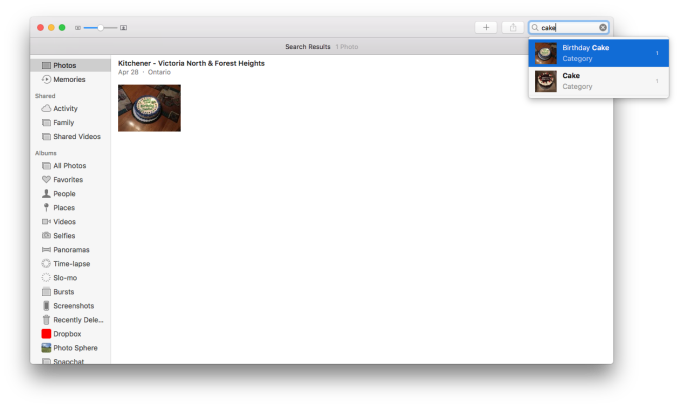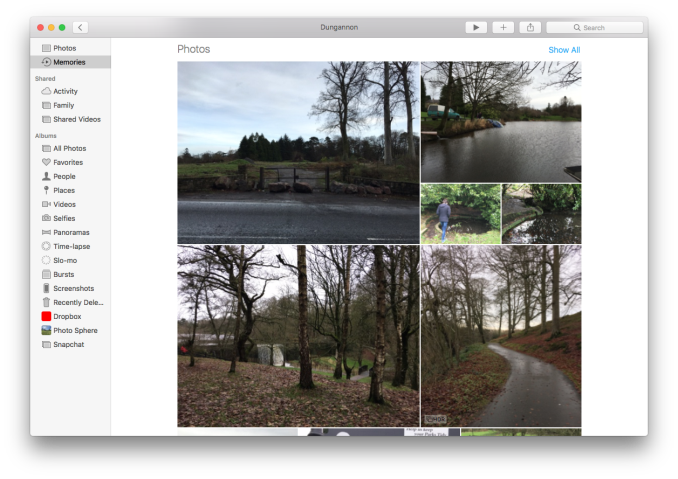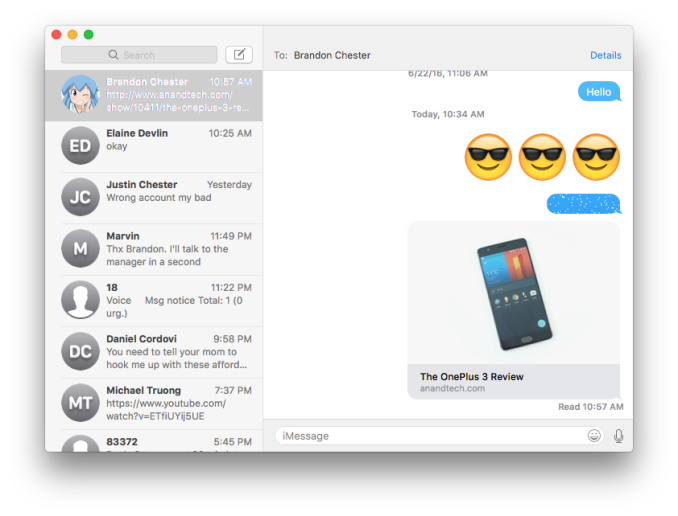A First Look At Apple's macOS Sierra
by Brandon Chester on July 13, 2016 8:00 AM EST- Posted in
- Mac
- Apple
- Operating Systems
- macOS
Photos
The Photos application for OS X was unveiled alongside OS X Yosemite, but while Yosemite launched in the second half of 2014 it wasn't until mid-2015 that the Photos app was officially released. Photos provided a great way to organize all the photos that users take on their iOS devices, and integration with iCloud and the new iCloud Photo Library was clearly something kept in mind during the development process, while Apple's previous attempt to integrate iCloud into iPhoto using Photo Stream felt like a tacked on feature.
While Photos and iCloud Photo Library provide a simple way to make photos accessible across all Apple devices, they haven't done much to help with organizing those photos. Apart from the most basic categorization like automatic albums for panoramas, selfies, burst photos, etc, the only automatic detection based on the content of a photo is the Faces album which tries, not always successfully, to generate an album containing photos where people's faces are visible. Around the same time, Google launched Google Photos, which employs machine learning to do image analysis which enables categorization and search on sets of photos based on the contents of the photos themselves.
With Photos for macOS Sierra and iOS Apple is now employing machine learning as well. Much like Google Photos, you can now search for photos based on the content within them, and the app will now generate groupings of photos that are related. The search generally works as expected, although there are limitations to what sort of objects the system has been trained to recognize. The most interesting situation I found was the one above, where it correctly distinguished between a normal cake and a birthday cake and presented two separate search results where the birthday cake result had only the cake images where the happy birthday text writting in icing was visible.
For photo organization there's a new feature called Memories. These are essentially groupings of photos that are related based on context and metadata. At this point the feature has only generated one memory for me, but I have a number of images from trips and events in my iCloud Photo Library and I'm not sure why it hasn't generated one for those as well. The memory it did generate was of my trip to Ireland and Northern Ireland, and it grouped the photos taken at a park there by me and a friend of mine.
Apple also has a new editing option called Brilliance. This setting essentially works to improve the exposure of an image selectively by brightening darker areas but leaving properly exposed areas as they are. For instance, it may lighten a harsh shadow significantly while only slightly adjusting the well-lit area. This slider can be thought of as one that automatically applies the other adjustments that are available individually in order to achieve a certain result. I don't do any photo editing in the macOS or iOS Photos apps, but I suppose that the ultimate goal with consumer photo editing has been making a single-action system for fixing issues with images, with Brilliance being like a more fine-grained version of one click auto adjustment features.
Messages
At WWDC there were a number of new features shown for the Messages application on iOS that will be coming in iOS 10. Given that iMessage exists on both iOS and macOS, it makes sense that support for these features is coming to Sierra as well. The situation isn't as simple as one might think, as while you can receive messages using all the new features on a Mac, you can't send messages that make use of features provided by iMessage apps, and you can't use some of the features that were designed for the multi-touch interface of iOS.
The core interface of Messages is pretty much unchanged. Right now Apple has changed the default contact avatar, but these kinds of changes often change multiple times over the course of the iOS and macOS beta cycle. In the screenshot above you can see Apple's new 3x emoji. When sending emoji alongside text the message renders at its typical size, so this just applies to messages that only have emoji in them. The display of messages that have links is also much better. Previously they simply displayed the link as text, which felt really antiquated compared to apps like Skype and Hangouts that give you a preview, and now iMessage does the same.
Messages for macOS includes support for the new message effects that will be coming in iOS 10. There are effects to make messages that scale up in size to emphasize loudness, or come in with the text obscured until you wipe the effect away to reveal the text. You can receive these messages on macOS, but you cannot apply them to the messages that you send.
The one feature that does make its way to macOS is support for placing a reaction on a message. By long clicking on a message you open a menu that has a number of responses. Applying one of these to a message applies an icon on the corner of the message corresponding to the reaction, and options like the humor reaction provide a good way to cut down on the number of messages that simply say "lol".
I do feel that Apple could have found a way to implement more of the new iMessage features in the macOS Messages app. For example, you could implement message effects on macOS with a simple tooltip menu or a popover, even if the interface still does work better within the multitouch interface of iOS. On the other hand, when I send messages on macOS I tend to just type it in and hit enter to send, and I probably wouldn't end up using the message effects as much as on iOS due to the greater friction in the interface. I can see how the decision may have come down to weighing the balance between the engineering effort required and how well it would actually work on a desktop or laptop.














81 Comments
View All Comments
Ranger1065 - Thursday, July 14, 2016 - link
Lol. RiP Anandtech.Cygni - Wednesday, July 13, 2016 - link
Nobody cares about what you think a websites 'identity' is or was. Go someplace else if you don't like the content.cknobman - Wednesday, July 13, 2016 - link
What amazes me is we get the huge "preview" of this mac OS update, which does not come out until fall, but we get jack shit on the Windows 10 anniversary update which comes out August 2 and has some pretty huge things in it.Ya know, I realize people use Macs but there are about 8x more Windows users out there that would appreciate some coverage on that OS too.
michael2k - Wednesday, July 13, 2016 - link
I remember when it was 9x more Windows users. How time flies.I'm sorry Windows users aren't as important. I'd like to know about the update as well, and rely on Ars Technica. Not as in depth, but more timely:
http://arstechnica.com/information-technology/2016...
fanofanand - Wednesday, July 13, 2016 - link
A 90% review (depth) is better than the 0% we have been getting here.Ryan Smith - Wednesday, July 13, 2016 - link
We have something lined up for the Windows 10 update as well, once that ships.Friendly0Fire - Wednesday, July 13, 2016 - link
I have to ask... Why not release it early, as a preview? Why wait for it to ship, since you didn't do that for Apple?cknobman - Thursday, July 14, 2016 - link
Thanks for the update Ryan.But I have the same question as Friendly0Fire.
Why do we get this huge article on Apple OS update that wont even come out until fall but for Windows 10 you are waiting until it ships?
Meteor2 - Wednesday, July 27, 2016 - link
Yeah, me too. Windows 10 Anniversary is a much bigger deal than macOS. Where's the preview?KoolAidMan1 - Thursday, July 14, 2016 - link
Are you new here? Anandtech always takes time because of how thorough they are.People come here for detailed and objective analysis. If you want a quick fix then there are dozens of other tech sites out there